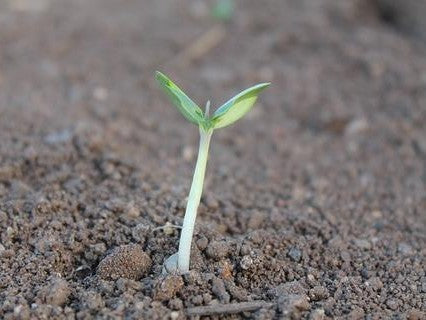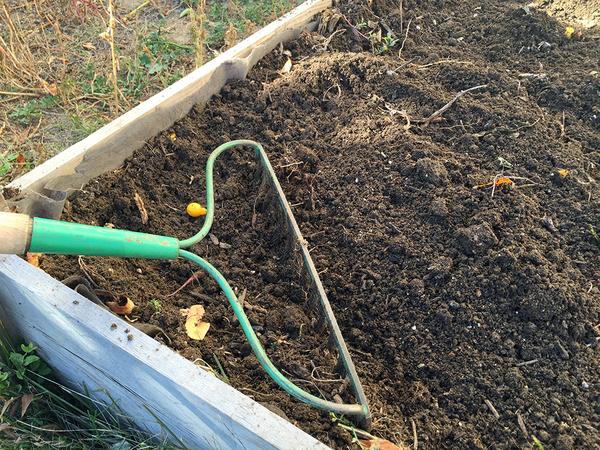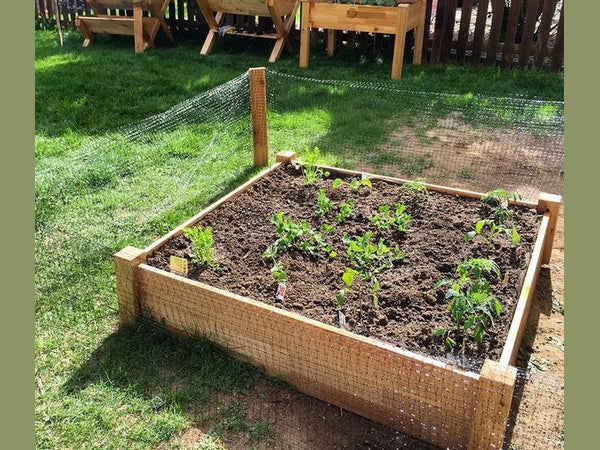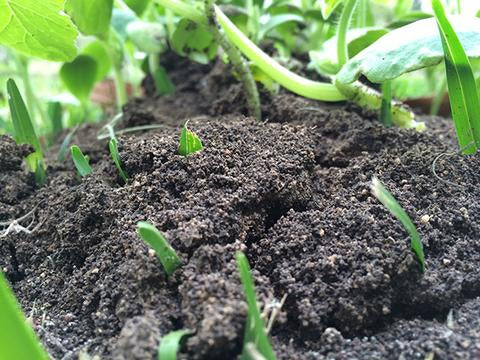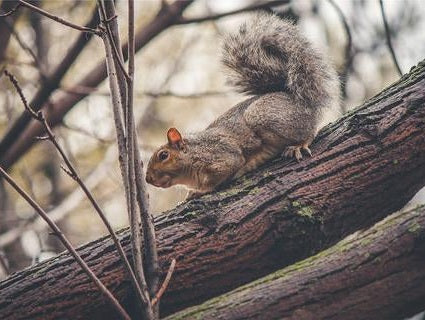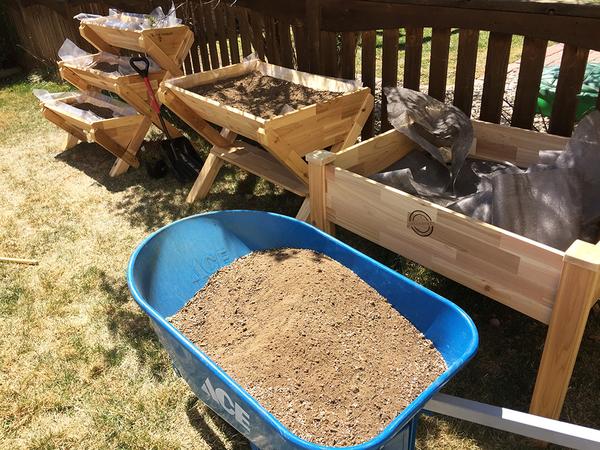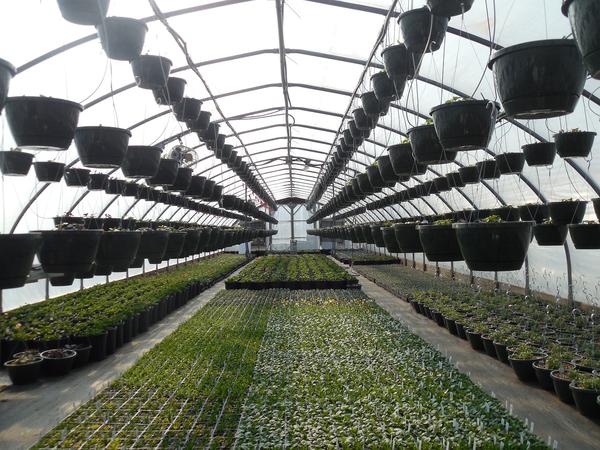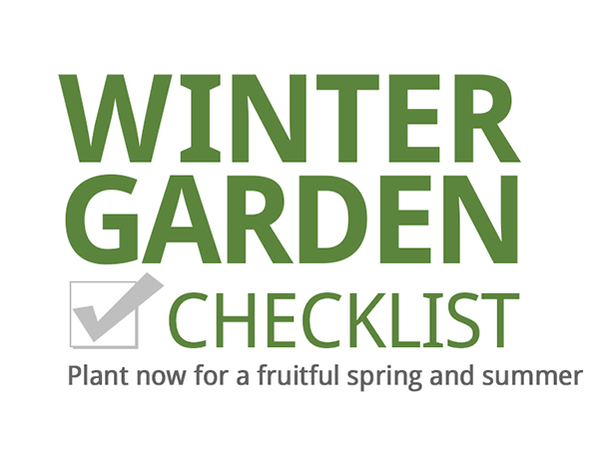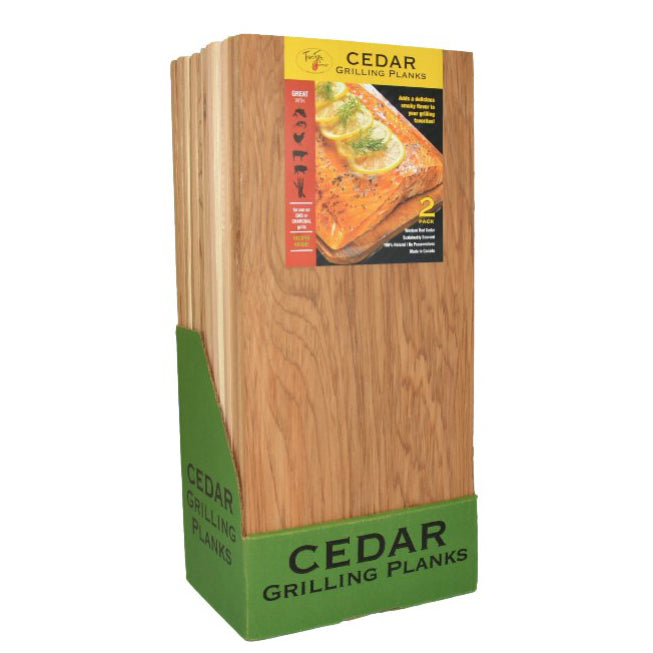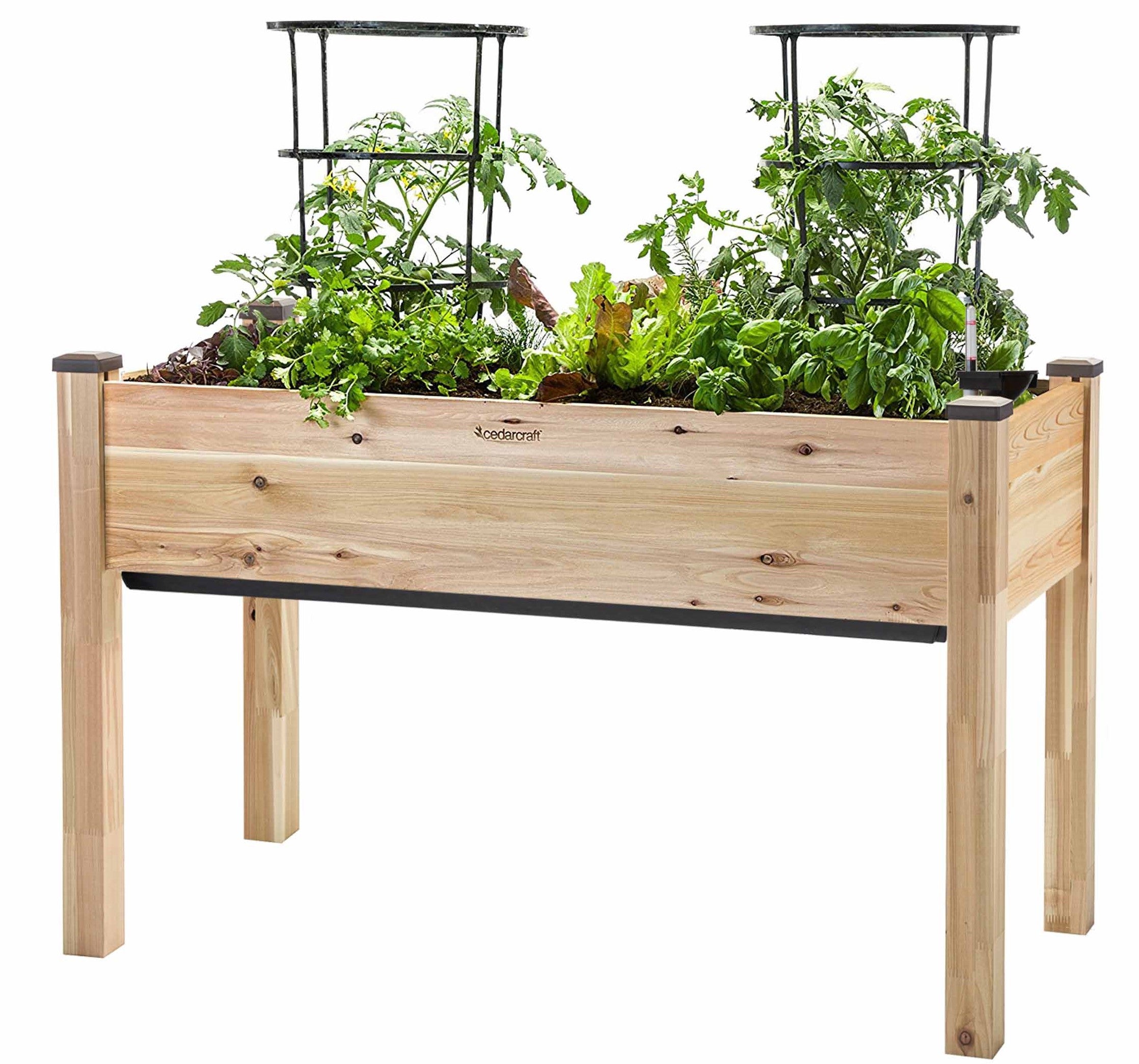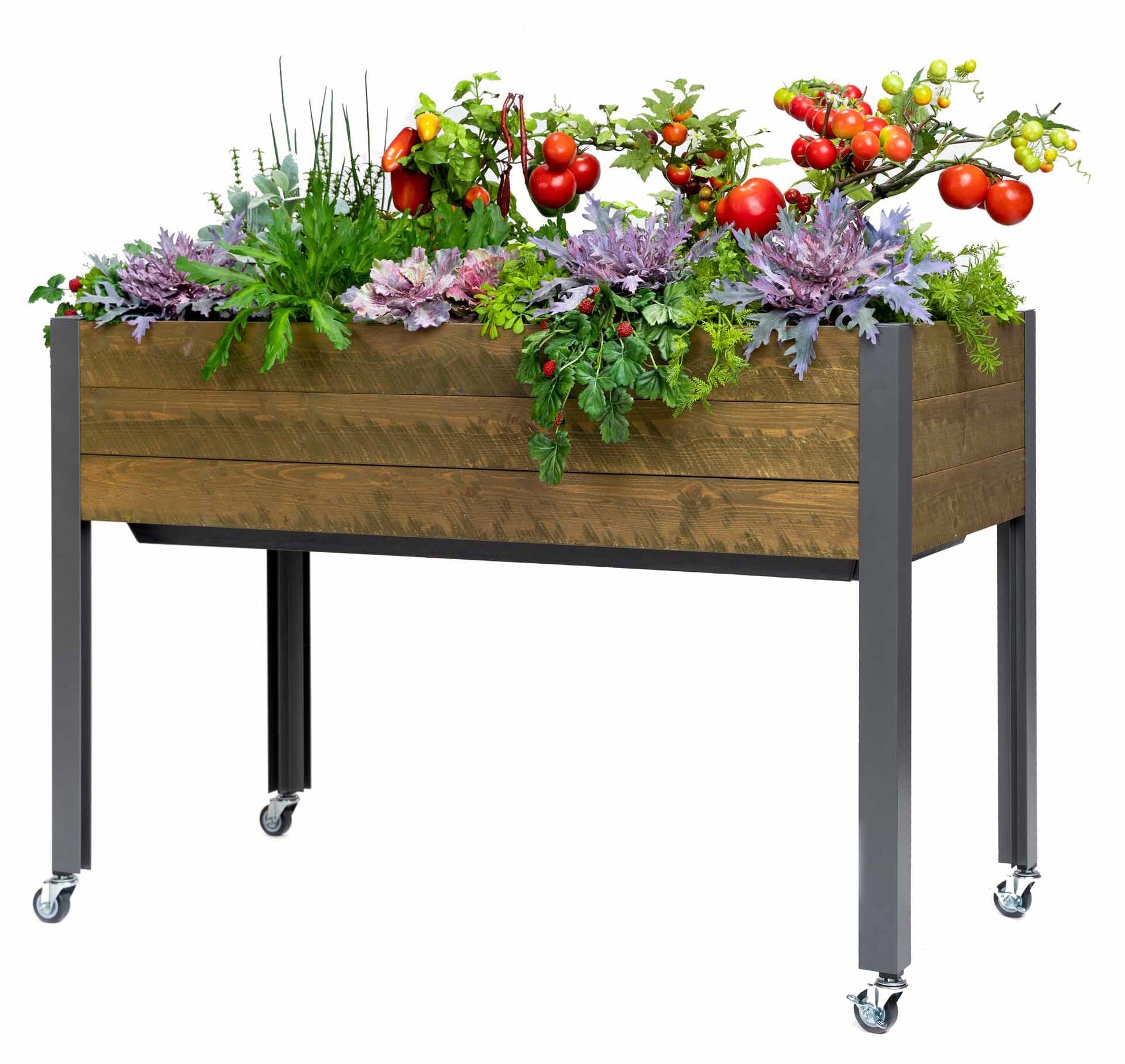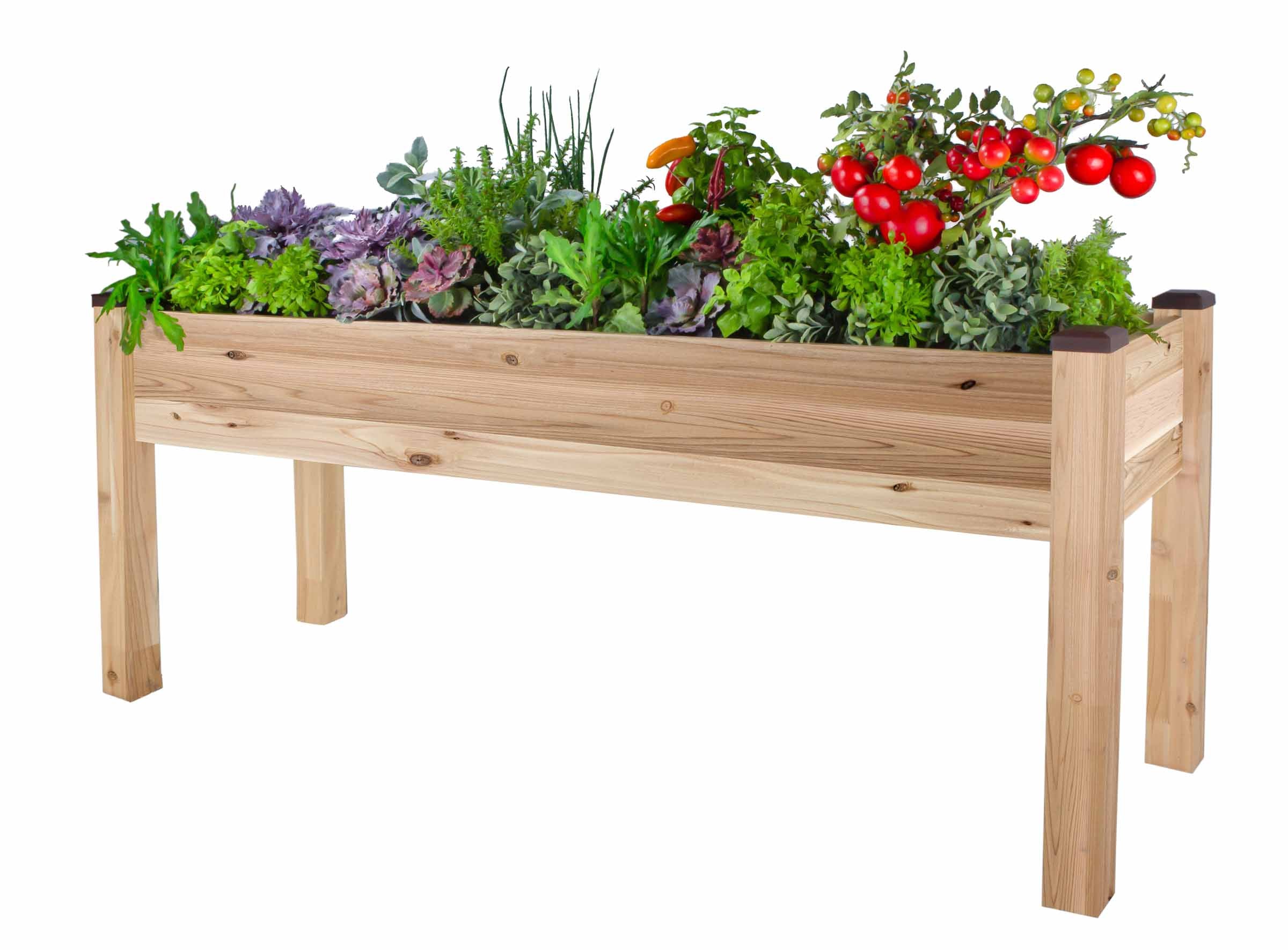Gardening Adventures
Putting Your CedarCraft Garden To Bed
The first frost is just around the corner, if not already here, for many gardeners in colder climates. Harvest season is over and winter is creeping its cold, icy fingers into garden beds. It’s time to clean up and prepare for next spring by putting your CedarCraft garden to bed. Putting in the extra cleanup effort at the end of fall will help you start your spring gardening season off on the right foot. Your planters will be clean, and filled with healthy, warm soil earlier than gardeners waiting for the ground to thaw out, which means you get a gardening head start on everyone else! Here are the simple steps that you need to do to put your gardens to bed: Pull Out The Old By this time in the season many of the vines and stalks have wilted as they have finished their production. Flowers have gone to seed, and leaves have fallen. Pull up tomato, squash, pea, and bean plants, and leave your fall plantings of cold weather vegetables like kale and lettuce to harvest throughout the remaining season. Make sure to double check if your fruits, flowers, and herbs are perennials or annuals. Annuals will get cleared out from the planters, but your perennials, like strawberries, can stay in with a bit of pruning and some mulch to keep them warmer. You can protect tender perennials with a row blanket or plant blanket as well. When clearing things our, a good rule of thumb is that if a plant is yellow or brown, cut it down, if it’s green leave it be. Turn The Soil Once you have the old and dead plants cleared out, till the soil to get some oxygen in there, break up clumps from remaining roots, and encourage bugs and pests to find new homes for the winter. Add a layer of compost to the mix and top it off with mulch or autumn leaves that will break down over the winter season and add more nutrients to your planter garden bed. Plant Spring Bulbs Now is the perfect time to get your spring bulbs in soil. They’ll even grow well in a planter! Spread out your tulip, crocus, and other spring bulbs in your planter. Make sure to add a variety of early, mid, and late spring blooms for continued variety throughout the flowering season, right before vegetable planting season begins. Make sure you plant the bulbs with the pointed tip side up, push them down a few inches into the soil, and cover with mulch to protect them from winter soil cracking. Now kick back and enjoy your gardening break during the winter!
Learn morePlanting Your Garden
The sun is shining, the grass is green, it’s time to get your hands dirty and plant your garden! Here are the things we've covered in other CedarCraft blog posts on what you need to know before you get those plants in your soil: How much soil do you need and what kind of mix? How to plan out your garden - considering square foot layout and companion planting How to keep critters out of your garden Now it’s time to get the details on how to plant a plethora of fruits, herbs, and vegetables in your planters! If you are a beginner gardener, your best bet is to establish your garden with starters rather than seeds. This will reduce the margin of error for you as you gain more hands-on experience. When choosing where to purchase your starters, avoid Big Box hardware and garden stores. They often have plants that are sick with disease, which will spread to healthy plants in your planters. Visit your local garden center where the plants have been grown there or the surrounding area. Plus, the gardeners working there LOVE to share their wealth of knowledge to help you out. Local farms and CSA’s will have plant sales in the spring, giving you the opportunity to grow exactly what your favorite farmer has decided to produce for crops that year. These are generally organic and GMO-free plants as well. Horticulture organizations and university departments will host starter sales as a fundraising source for students. This is a great way to get plants at an affordable price while supporting local gardeners in your area! Once you’ve purchased your plants, roll up your sleeves, because you’re about to play in some dirt. Because you’ve mapped out your garden, getting the plants in is pretty easy. A calm, overcast day is ideal for planting conditions, but it’s not a problem if you’re planting on a sunny weekend. Make sure your plants are well watered in their cell containers and stay nice and snug in there until the very last minute. You want to protect the tender roots from sun and wind exposure to reduce the amount of shock they’ll go through in the transferring process. Prepare your soil by watering your planter so that the plants aren’t going in dry spot. They’ll need a lot to drink to get established! After digging each hole, add some more water before placing the plant in. Then after gently covering the top (not packed down, because the roots need air), water it again. Transferring plants can be a stress on their roots and health, so you’ll need to keep a close eye on them for a week or so. Make sure there’s enough water to keep the soil moist, but not too much to drown them. You may need to water frequently if you see them begin to wilt. You may also want to shield them from sun and wind during that week if your climate is especially harsh. After a week or two, their roots should be established and leaves will be a perky green as they have settled into their new CedarCraft planter home!
Learn morePlanning Your Garden
Gardening is a treasured hobby for many people. It’s a way to relax, spend time connected to the Earth, all while providing a moment to breathe in the aromas of soil and flowers. It’s also a way to become food-independent, allowing people to grow their fruits, vegetables, and herbs on their own – the way they want it grown. However, that’s not true for everyone! Gardening may seem intimidating to others, especially beginner gardeners who don’t have the years of hands-on experience. People who’ve never started their own garden often say they have a “black thumb” holding the perception that there’s a steep learning curve to growing plants. We’re going to help make it a little easier for you! At CedarCraft, we’re big fans of the Square Foot Gardening concept developed by Mel Bartholomew. Square Foot Gardening is a uniquely simplified system of gardening that eliminates 80% of the: Space Work Weeds Watering Waste Square Foot Gardening creates a planting grid within your planters with each crop having its own square. There are four spacing guidelines: Extra Large fruits and vegetables are allowed one plant per square for 12 inch spacing Large fruits and vegetables have 4 plants per square for 6 inch spacing Medium allows for 9 plants per square for 4 inch spacing Small fruits, vegetables, and herbs have 16 plants per square for 3 inch spacing. You can use the seed packet to find out what spacing your plant needs. A tomato or green pepper plant needs one per square, while radishes and carrots need 16 per square. There are online planning guides that can help you map this out, too. This system works perfectly with your CedarCraft planters. We’ve broken down the square feet in each one of our planters for you: CedarCraft Cascading Planter CedarCraft Elevated Planter CedarCraft Urban Planter CedarCraft Raised Garden Planter Once you have a grid system mapped out, you’ll need to double check a companion planting guide to make sure your plants can share the same planter. Some plants don’t grow well together. Beans: Don’t plant near chives, garlic, leeks, onions, peppers, marigolds Peas: Don’t plant near chives, garlic, leeks, onions, peppers Broccoli and Cauliflower: Don’t plant near peppers, squash, strawberries, tomatoes Tomatoes: Don’t plant near broccoli, cauliflower, cilantro, cucumbers Dill: Don’t plant near carrots You can follow our CedarCraft Pinterest boards for gardening tips, companion planting guides, and examples of what people are growing in their own Square Foot Gardens!
Learn moreTips on Keeping Critters Out
You have your CedarCraft planters, you’ve filled them with soil, and you’re getting ready to plant your seeds in preparation of growing a delicious harvest. But, you notice that it’s not just you who will enjoy the fruits of your labor; backyard critters are ready to dig in to their new planter buffet! Some of our planters are raised up enough that they’ll keep out voles, rabbits, and pets – like our Elevated and Urban planters. You may need to take precautions to repel squirrels, deer, and birds. A few of our other designs, like the Cascading planter and the Raised Garden planter are low enough that neighborhood animals can hop right in to help themselves. Shortly after our Colorado team filled planters with soil, and before planting seeds and sprouts, we discovered that the rascally rabbits were quick to hop in and spread out, calling dibs on their new comfortable dirt beds. We’re particularly fond of our backyard bunnies, but we are also protective of our vegetables that we’d like to feed to our family. We want to find a way that we can share our environment harmoniously. Here are some thoughtful tips on how to safely keep the critters out of your garden: Fencing This is the best way to prevent all types of neighborhood animals from staking claim to your garden. This will keep the rabbits, raccoons, squirrels, deer, and birds at bay, and it’s easy to build. This works especially well for our Raised Garden and Elevated planters. You can make your fence as elaborate or as simple as you’d like. All you need is to nail a bottom frame together, the same size as the planter. Create a type of hoop-house with PVC piping and deer netting over the top. Here's a handy how-to article with specific instructions. Repellants Small rodents like rabbits and squirrels can be deterred by unsavory scents, like those of a predator and strong-smelling herbs. You can sprinkle fox and coyote urine products around the base of the planters. Blood meal mix can work in the same way, too. Planting garlic, hot peppers, and onions to your garden boarders is an option, plus you get the benefit of the delicious foods you’ve planted. Feed Them While it sounds like this option is encouraging nibbling on your garden, creating a critter bed with things for them to eat on the opposite side of your yard can keep them full and distracted enough from trying to get into what’s yours.
Learn moreHow Much Soil Do You Need?
Spring is here and it’s time to start getting your CedarCraft planters ready! You have them assembled and it was a snap. But now it comes down to the dirty work – filling them with soil. You may be wondering, how much soil do I need to fill this? You may have read our previous blog post on Soil 101 for container gardening. That post gave you some insights on why your container soil is so important for your garden planters and that you shouldn’t dig up dirt from your yard to fill your raised bed. This weekend our CedarCraft team assembled our planter collection and filled them all with a container gardening mix. We’re going to give you some step-by-step instructions on what you need to do to fill your planters. Calculate Cubic Volume First you need to break out the calculator and figure out how much soil your planter needs. You can find a plethora of gardening calculators from a simple Google search. Here’s a handy calculator on Home Depot’s website. To determine how much soil you need to fill your planter or raised bed, these are the dimensions you need for your formula: Length (in inches) x Width (in inches) x Depth (in inches) = total amount of cubic feet or cubic yards of soil. (12 cubic feet of soil = 0.444 cubic yards of soil) We’ve made it even easier for you! If you take a look at our collection descriptions, we have cubic feet of soil capacity for each planter listed: CedarCraft Cascading Planter: 5 cubic feet = 0.1 cubic yards = 77 quarts CedarCraft Elevated Planter: 4 cubic feet = 0.1 cubic yards = 102 quarts PatioCraft Elevated Planter: 6 cubic feet = 0.2 cubic yards = 179 quarts CedarCraft Urban Planter: 5 cubic feet = 0.1 cubic yards = 128 quarts CedarCraft Raised Garden Planter: 11.5 cubic feet = 0.4 cubic yards = 295 quarts PatioCraft Raised Garden Planter: 16 cubic feet = 0.6 cubic yards = 478 quarts Fill With The Right Mix Now that you know how much soil you need, you need to know what kind of soil to fill it with. Since our team filled each planter in our whole collection, we visted our local commercial soil source recommended by landscapers and contractors. We needed a lot of soil and it filled our truck bed! If you have one or two planters, you won’t need to go to these lengths. We used a soil mix with 60% topsoil and 40% compost, and then added an additional 10% vermiculite to that. With shovels in hand, we poured the vermiculite into the truck bed on top of the soil and got to work mixing! With smaller projects, you can pour your soil mixes onto a tarp and rotate. You can also create your own Mel’s Mix we mentioned in our Soil 101 post with this recipe: 1/3 peat moss 1/3 compost 1/3 vermiculite Before you add soil to your planters, make sure you have your liners in place. You will need landscaping fabric for your Elevated and Raised Garden planters. Now you know what kind of soil mix to use and how much, all that’s left is adding it to your planters. Happy gardening!
Learn moreGetting Started With Planting
Now that you have your new CedarCraft planter, and you’ve prepared the perfect soil to keep your plants growing healthy and strong, it’s time to start planting! This is one of the most exciting parts of gardening because it’s the beginning of life for your plants that will soon reward you with a bounty of fruits, vegetables, herbs, and blooms. With spring making its way to your yard, here’s what you need to know to start adding those seeds and sprouts to your soil! For The Beginner Gardener Your interest has been piqued and you’re starting your gardening adventure for the first time. There’s so much to learn! You may be feeling a little lost in the beginning. There’s no need to hesitate – jump right in with your new green thumbs! Gardening can be a life-long learning process that often takes hands-on experience, but there are a variety of resources to help a budding gardener bloom. Start with a trip to your local nursery. Your nursery gardeners love to talk about their passion and pass on their wealth of knowledge. They want to help foster that love of gardening in others. They are more than happy to answer all of your questions, point you in the right direction for information, and help you know what will grow best in your hardiness zone. For your first few seasons you’ll want to start with transplants instead of starting your garden from seeds. Garden centers, nurseries, and horticulturist organizations will host spring plant sales. They’ve done all of the seed-to-sprout work for you and will tell you all that you need to know to keep them growing. Some nurseries offer gardening classes to help you learn more about soil, how to transplant sprouts, and what to do when challenges arise. Check your local garden center website to see what might fit your needs. Other new gardeners may want additional help. Some nurseries offer custom annual container gardens. You can drop off your CedarCraft planter and the landscape designers will create colorful, low-maintenance annual flower combinations that can bloom all summer long. If you’ve thought about gardening for the first time but have hesitated to start because you’re unsure of what to do, don’t let time and the opportunity to garden pass you by. There are a variety of resources and people to help you out!
Learn moreWinter Gardening Checklist
Seed catalogs in hand, raised garden bed space mapped out – you’re ready to get started on your 2015 garden! But, we’re still in the middle of February. It’s the tail end of winter and in some states across the US, a deep layer of snow has settled over backyards and patios. Gardeners everywhere are anxiously awaiting the warm sun on their skin, the soft grass under their feet, and the spring air to fill their lungs. While we’re waiting for gardening season to really start, there are a few things you can do during the winter to start your garden with the perfect sprouts. Here’s our winter gardening checklist to help you grow your best garden yet! Tip 1: Plant Cool-Season Plants Now For A Delicious Spring Bounty Spinach This super-cold-hardy vegetable is a tender crop that can be planted in very early spring as well as winter. Spring plantings can be made as soon as the soil can be properly worked. It's important to seed as soon as you can to give spinach the required 6 weeks of cool weather from seeding to harvest. Peas Sow seeds outdoors 4 to 6 weeks before last spring frost, when soil temperatures reach 45 degrees F. Be sure to add a tomato cage so the pea plants will have something to climb. Carrots Carrots get sweeter as the temperature cools. Plan to plant seeds outdoors 3 to 5 weeks before the last spring frost date. Tip 2: Use Raised Beds To Reduce The Risk Of Stepping On And Compacting Soil When your soil is compacted, your plants can’t grow well. Compaction is what will decrease the amount of air by the roots, inhibiting growth by making it more difficult for the sprouts to break through the surface of the soil. Raised garden beds make it easier to work around the plants without stepping on the soil, keeping it nice and airy! Tip 3: Wrap Growing Plants In Horticultural Fleece Before Frost Sets In Horticultural fleece provides a simple way to give plants some minimal winter protection. Fleece can laid over soil and pegged down, or wrapped around a plant and tied in place with string around the stem. The ease of applying and removing the fleece makes this a good temporary protection solution. Tip 4: Insulate Planters To Avoid Continuous Freezing and Thawing Container soil in raised garden beds will rarely freeze and is easy to maintain over the winter by covering your raised garden bed with leaf mulch or a tarp. Because the soil maintains warmth, it's less work for you and it extends your growing season! If you do find cold soil to be any problem, you can place rocks in your garden to help distribute heat from the sun. With container gardens, frost can easily penetrate the sides of planters and kill roots. You can wrap the entire exterior of your planter in hessian or bubble-wrap to insulate the soil and roots of your vegetables. Keep the top of the planter free so you can continue to water your plants. If you’re as excited about the kick-off to gardening season as we are, you can enter our Facebook giveaway for your chance to win your choice of Cedarcraft planters! Five winners will be chosen on March 15th. Click here to enter!
Learn moreHow To Get Your CedarCraft Garden Started
Getting your urban garden together doesn't have to be a complicated process. You may live in a small space, or have limited resources, and the thought of constructing a planter might seem like a daunting process. Luckily, it isn't with CedarCraft! One of the great things about CedarCraft planters is that you don't have to spend a lot of time or effort putting them together. With just a few simple steps, and no tools needed, you can make your gardening ideas come to fruition in a matter of minutes. CedarCraft planters come with step-by-step instructions right out of the box. They're also available on our website. Each piece of the planter fits together perfectly and instructions are a breeze. Inside tip for your Urban Planter: make sure you assemble the leg pieces so that the dowel holes are facing toward the inside of the planter and the panel grooves are on the outside edge. You'll know if you've mixed them up on step 3. It will only take you 10 minutes to assemble your planter and you're right on your way to growing your dream garden! A video posted by CedarCraft (@cedarcraft) on Jan 21, 2015 at 12:24pm PST
Learn moreIt all starts with an idea
Welcome to CedarCraft's blog where we are going to help your ideas come to life! Each month we're going to share tips and inspiration to help you add freshness and beauty to your home in creative and simple ways. We'll help you get the most out of your raised gardens for a successful harvest of herbs and vegetables. And we'll share easy design projects to add that "something special" to your living spaces.
Learn more

